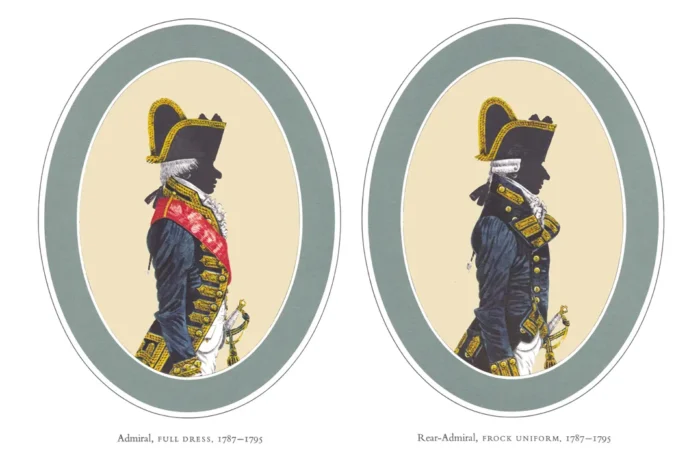(I) Admiral, Full Dress
(II) Rear-Admiral Frock Uniform
£15.00
(i) Admiral Full Dress, 1787-1795
(II) Rear Admiral Frock Uniform, 1787-1795
(scroll down for a more detailed Description)
Published 1965 © Hugh Evelyn Limited; drawn by John Mollo (1931-2017)
Size: c. 38 x 25 cm. [15″ x 10″] may vary slightly from printers’ cut 50 years ago
Printed on high white heavy cardstock 149 g/sm²
This is a STANDARD sized print – shipping is the same for 1 to 10 prints (based on largest print size in your order) – see Shipping & Returns
In stock
- Satisfaction Guaranteed
- No Hassle Refunds (see Shipping and returns)
- Secure Payments
Description
I. Admiral, FULL DRESS, 1787-1795: This plate is based on a portrait of Lord Rodney by L. J. Mosnier. He is best known for his commands in the American War of Independence, particularly his victory over the French at the Battle of the Saintes in 1782. It is often claimed that he was the commander to have pioneered the tactic of “breaking the line”. At the beginning of the Napoleonic Wars the only decorations which an officer might receive were the Order of the Bath, and, very occasionally, the Garter. With the Bath, the star was usually embroidered on the left breast of the coat, and the red ribbon worn over the right shoulder, in full dress over the coat, and in undress under the coat and over the waistcoat.
II. Rear-Admiral, FROCK UNIFORM, 1787-1795: This is the undress uniform for flag officers. This plate is based upon 2 paintings of Lord Howe: Henry Singleton’s portrait and Maher Brown’s portrait of Earl Howe. on the deck of the Queen Charlotte at the Glorious First of June, 1794. Admiral of the Fleet Richard, 1st Earl Howe, KG (1726 – 1799) served throughout the War of the Austrian Succession and gained a reputation for his role in amphibious operations against the French coast as part of Britain’s policy of naval descents during the Seven Years’ War. He also took part, as a naval captain, in the decisive British naval victory at the Battle of Quiberon Bay in November 1759.
Additional information
| Dimensions | 38 × 25.5 cm |
|---|




